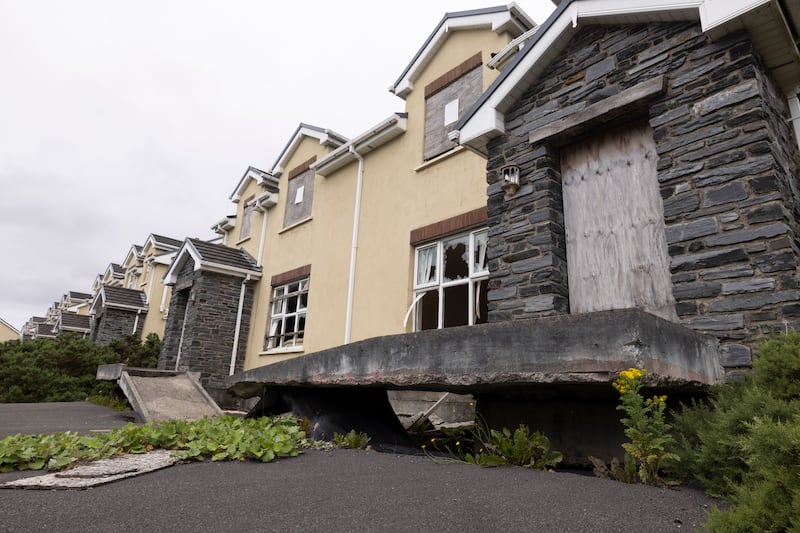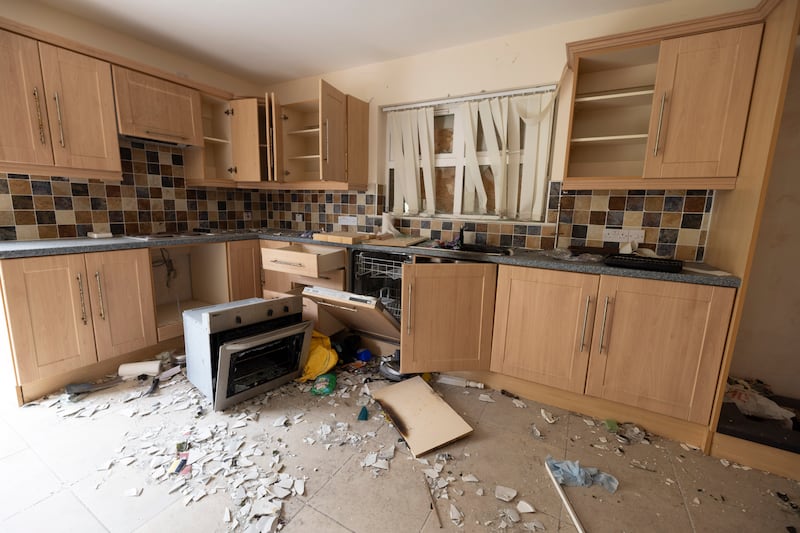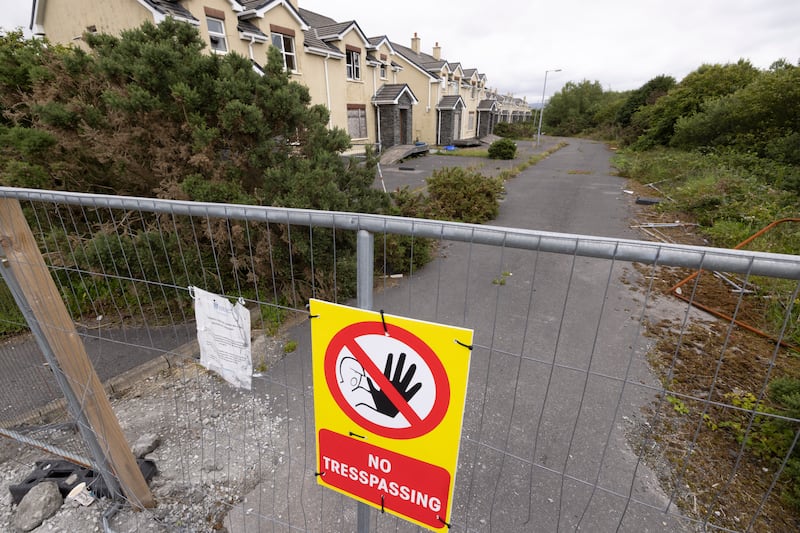Overlooking Dungloe Pier on the west coast of Co Donegal lies a vacant housing estate comprising 15 properties.
The homes off Pole Road in Meenmore have been left idle for more than 15 years, with the estate referred to as “the Titanic” by some locals.
Radharc An Seascan was completed around 2007, but within a year the entire site suffered serious subsidence.
Owners said this was because the three-bedroom semidetached homes had been built on a peat bog, causing steps and ramps to detach from walls and tarmac to sink, water pipes to break and central heating and drainage/sewage systems to be damaged.



The owners sued the builders, O’Kane Developments (Northwest) Ltd, which went into liquidation and became insolvent in 2017, and the engineers/architects Damien McKay Ltd, which also went into liquidation and was wound down.
Liability was accepted by Aviva Insurance in its capacity as the insurers for McKay and it’s understood the owners, who paid between €155,000 and €190,000 for the houses, received settlements years later.
Those who had been living in the houses vacated them shortly after the problems started to emerge and the properties have remained vacant ever since. Most of the owners told the High Court in 2012 that the estate should be levelled. The court heard the properties had mostly been sold to people from Northern Ireland, who bought them as holiday homes and rental investments.
A number of the houses’ windows and back doors have been smashed, and some have been boarded up with steel shutters or blocks. Others have had their wooden front doors completely destroyed.






Large gaps between tarmac and house entrances and walls are now visible, with shattered glass all over the estate. Inside the houses there is more smashed glass and porcelain, graffiti on walls, old children’s toys, mattresses, broken furniture and televisions strewn around the floors.
Some kitchens have been totally removed while damaged fridges and ovens have been discarded in others. Evidence of squatting can be seen upstairs in some properties.
[ Residents in ‘dangerous and unhealthy’ Dublin flats to meet council ]
Independent councillor Micheál Choilm Mac Giolla Easbuig says his parents previously owned a window blind company and he remembers fitting the houses with them.
“People were so delighted to get a new home and a new beginning,” he says. “It’s terrible. Seascann means swamp in Irish, so Radharc An Seascan literally means ‘the swampland’ or ‘bog view’. These houses should never have been built here.
“I have people in this town who are sleeping in cars and these houses are in this shape. You can see the graffiti on one of the houses’ walls here that says ‘we need homes’. For us as a community it’s embarrassing and it’s an awful shame.”
The local councillor says he has been raising the issue at council meetings for years but been repeatedly told “because it’s a private development, our hands are tied”.
Donegal County Council says there were no third party submissions made on foot of the development’s planning application at the time. It is understood gardaí contacted the council in May 2024 following complaints of antisocial behaviour and safety issues.
People were so delighted to get a new home and a new beginning. It’s terrible. Seascann means swamp in Irish, so Radharc An Seascan literally means ‘the swampland’ or ‘bog view’. These houses should never have been built here
— Micheál Choilm Mac Giolla Easbuig
The local authority, which has legislative powers to address dangerous structures and derelict sites, subsequently fenced off the estate with hoarding barriers.
Donegal County Council’s regeneration team has been contacting property owners with a view to seeking their permission for structural engineers to carry out reports on the houses and site services to see if it is possible to bring them back into use.
Patricia McIntyre, the council’s town regeneration officer, says there are 14 different owners and they are “making good progress” contacting them.
“Our objective is to have a conversation with the owners to see what their intentions are for their properties, and if they are agreeable to us assessing their condition and exploring options, if it’s possible to bring the properties back into use,” she says. “This is the stage we are at, at the moment.”
Ms McIntyre says it is “unusual” for the council to become involved in a site that was a private development.
“We’ve stepped in here because we are about regeneration and we also believe with the number of dwellings and owners, it may be difficult for them to be able to take action or take the steps that we are doing.
[ Is Ireland ready for drab Soviet-style apartment blocks?Opens in new window ]
“This is the reason we’ve stepped in, because it is complex and we believe the local authority is perhaps best placed to seek this collective engagement to work through this process.”
The Department of Housing says it “would not ordinarily be involved with a case like this regarding a private development”.
The property price register shows that one of the houses was sold last year for €27,500.
Local resident Hugh Boyle says the site became an “attraction for young people” over the years and access into it remains easy, which “is a concern”.
“Because of the state of the place and the potential danger it poses there’s definitely a concern for ourselves that live so close with children and grandchildren, most of whom have an inquiring mind,” he says.
“It’s never really talked about. At the beginning it was named the Titanic, the sinking estate. We would have known ourselves here there were going to be issues. We were scratching our heads – why would anybody do what they were doing on bog land? We just couldn’t understand it, but it was none of our business.
“It is a shame, but I don’t know if there is even potential any more to house people there, if it’s feasible to come in and rectify all the issues. I’m very aware of the housing crisis and I would love to see families in there rather than what we drive past every day.”
Another local resident adds: “I heard at the time it was so bad that when people were running baths, the water was running down the stairs. You wouldn’t see a house like that. It’s terrible to see the way that it’s gone. Rats and everything could be in there, you just don’t know what’s going on.”
Fianna Fáil TD Pat ‘the Cope’ Gallagher says he lives “a stone’s throw” from the estate and is not aware of any antisocial behaviour at the site.
“From a structural point of view I don’t know what can be done,” the Donegal TD says. “It was a great disappointment at the time that it was found out much too late that there was a problem with the foundations.
“There’s nobody living nearer than I and I wasn’t aware of anybody misbehaving there and it’s not difficult to cordon it off. There’s only one entrance to it.
“I would certainly be supportive if something could be done structurally, but my understanding is they are too far advanced to be able to do that.”















